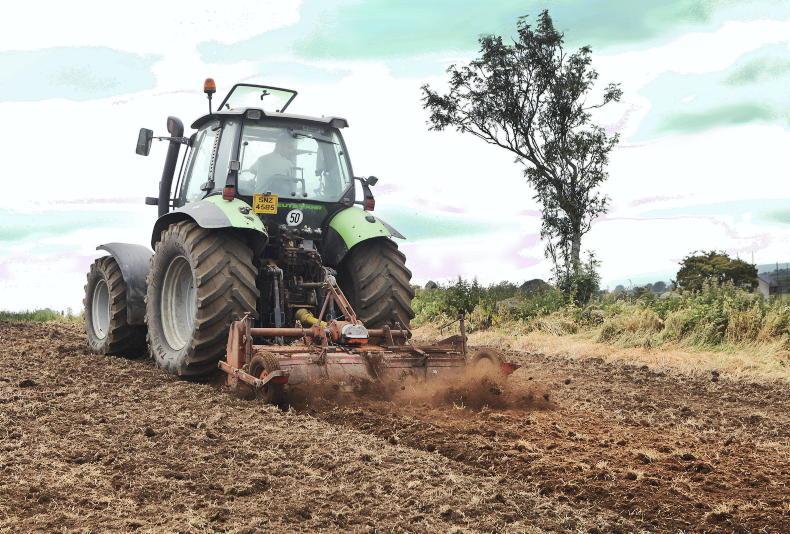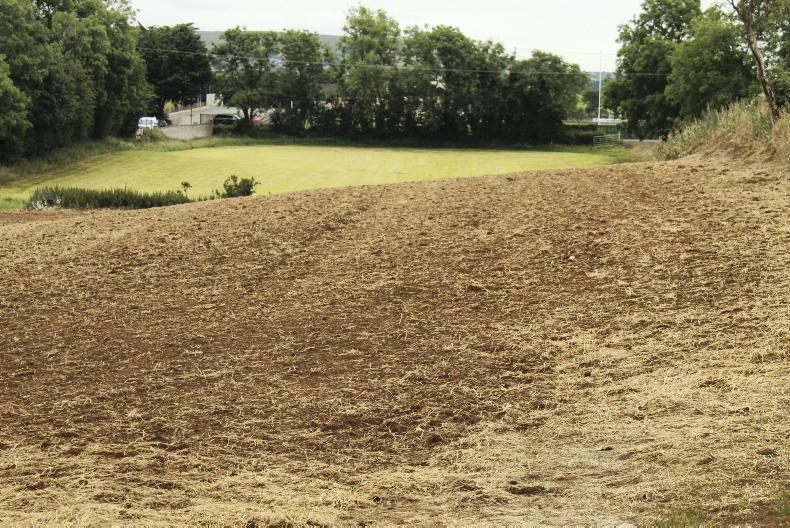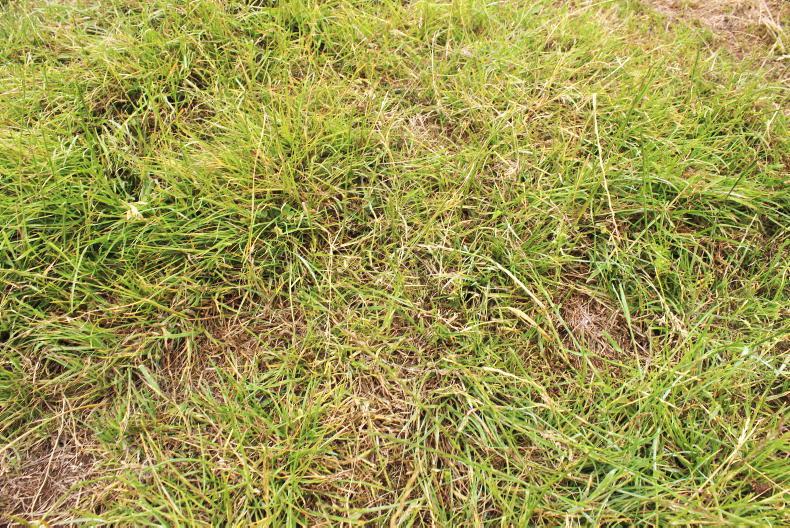Improving grassland management has been a big aspect of the Northern Ireland Sheep Programme. Within this has been a drive to improve soil fertility and reseed underperforming swards.
Dermot McAleese has just completed reseeding six acres of silage ground, undertaking most of the preparation work by himself.
As the field has a high stone content, Dermot opted for an over-seeding approach rather than ploughing down the old sward.
The silage ground lies adjacent to the main yard and is normally used for a two-cut system. Once second-cut has been harvested, after-grass is normally used for grazing lambs into autumn.
A brief overview of the reseeding process is outlined with accompanying photographs.
The old sward had a reasonable level of ryegrass present, but there was a considerable presence of older grasses that were less responsive to fertiliser.
First-cut silage was harvested on 20 May. The sward was allowed to regrow, before burning off on 12 June.

Once the old sward had died back, the field was rotavated twice on 30 June, with 2.5t/ac of lime applied on 5 July.
After spraying, the old sward was left for three weeks before seed bed preparation commenced. By this stage, the old grass was well desiccated.
The dead sward was not grazed by livestock. But with hindsight, Dermot indicates that this was something he would have potentially done differently, as there was a significant amount of dead grass to break down.

Dermot rotavated the field himself rather than using a contractor. He also power-harrowed the field on 10 July, before rolling. Grass seed was stitched in using a conctractor..
To break up the mat of dead grass and expose soil for drilling grass seed, Dermot rotavated the field twice on 30 June, which took around seven hours. Lime was applied on 5 July at 2.5t/ac.
The next step saw the lime worked in to the soil using a power harrow on 10 July. Again, Dermot undertook this job himself and the field was harrowed twice.
Once complete, the soil was rolled to tighten the seed bed. Grass seed was drilled on the same day using a local contractor.
Grass was stitched using a tine drill that broadcasts seed. The field was rolled afterwards to encourage greater seed-to-soil contact.

The lack of rain has meant that new grass has been slow to emerge. Once established, the sward will graze lambs this autumn.
The lack of rain has mean the sward has been slow to establish. No fertiliser has been applied as of yet, but one bag/ac of 20-10-10 will be spread to encourage seedling development once the rain comes.
Clover was included in the grass mix, which is outlined in the box below. A post-emergence spray will be applied depending on weed levels, but this is a step Dermot hopes will not be required.
Once the new sward is established, it will graze lambs late into autumn, which will help new grass tiller out.
Grass mix used for reseeding
The grass mix used in the reseed was supplied by a local merchant and has been used on the farm in previous reseeded swards to good effect. The grass mix is as follows:
3kg Abermagic – late- heading diploid.3kg Abergreen – late-heading diploid.3kg Aberwolf – intermediate-heading diploid.4kg Aberbite – late-heading tetraploid.0.9kg Aberdai – medium-leaf white clover.0.1kg Aberace – small-leaf white clover. Read more
Heatwave management: shelter for ram lambs and safe transport of sheep
Beef management: five tips for summer reseeds
Improving grassland management has been a big aspect of the Northern Ireland Sheep Programme. Within this has been a drive to improve soil fertility and reseed underperforming swards.
Dermot McAleese has just completed reseeding six acres of silage ground, undertaking most of the preparation work by himself.
As the field has a high stone content, Dermot opted for an over-seeding approach rather than ploughing down the old sward.
The silage ground lies adjacent to the main yard and is normally used for a two-cut system. Once second-cut has been harvested, after-grass is normally used for grazing lambs into autumn.
A brief overview of the reseeding process is outlined with accompanying photographs.
The old sward had a reasonable level of ryegrass present, but there was a considerable presence of older grasses that were less responsive to fertiliser.
First-cut silage was harvested on 20 May. The sward was allowed to regrow, before burning off on 12 June.

Once the old sward had died back, the field was rotavated twice on 30 June, with 2.5t/ac of lime applied on 5 July.
After spraying, the old sward was left for three weeks before seed bed preparation commenced. By this stage, the old grass was well desiccated.
The dead sward was not grazed by livestock. But with hindsight, Dermot indicates that this was something he would have potentially done differently, as there was a significant amount of dead grass to break down.

Dermot rotavated the field himself rather than using a contractor. He also power-harrowed the field on 10 July, before rolling. Grass seed was stitched in using a conctractor..
To break up the mat of dead grass and expose soil for drilling grass seed, Dermot rotavated the field twice on 30 June, which took around seven hours. Lime was applied on 5 July at 2.5t/ac.
The next step saw the lime worked in to the soil using a power harrow on 10 July. Again, Dermot undertook this job himself and the field was harrowed twice.
Once complete, the soil was rolled to tighten the seed bed. Grass seed was drilled on the same day using a local contractor.
Grass was stitched using a tine drill that broadcasts seed. The field was rolled afterwards to encourage greater seed-to-soil contact.

The lack of rain has meant that new grass has been slow to emerge. Once established, the sward will graze lambs this autumn.
The lack of rain has mean the sward has been slow to establish. No fertiliser has been applied as of yet, but one bag/ac of 20-10-10 will be spread to encourage seedling development once the rain comes.
Clover was included in the grass mix, which is outlined in the box below. A post-emergence spray will be applied depending on weed levels, but this is a step Dermot hopes will not be required.
Once the new sward is established, it will graze lambs late into autumn, which will help new grass tiller out.
Grass mix used for reseeding
The grass mix used in the reseed was supplied by a local merchant and has been used on the farm in previous reseeded swards to good effect. The grass mix is as follows:
3kg Abermagic – late- heading diploid.3kg Abergreen – late-heading diploid.3kg Aberwolf – intermediate-heading diploid.4kg Aberbite – late-heading tetraploid.0.9kg Aberdai – medium-leaf white clover.0.1kg Aberace – small-leaf white clover. Read more
Heatwave management: shelter for ram lambs and safe transport of sheep
Beef management: five tips for summer reseeds









 This is a subscriber-only article
This is a subscriber-only article










SHARING OPTIONS: